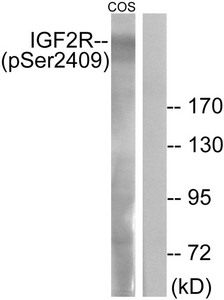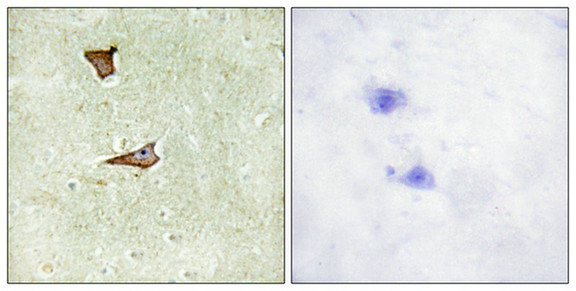
Western blot analysis of extracts from COS-7 cells treated with UV using IGF2R (Phospho-Ser2409) Antibody.The lane on the right is treated with the antigen-specific peptide.
Phospho-IGF2R (Ser2409) Antibody
CSB-PA973142
ApplicationsWestern Blot, ELISA, ImmunoHistoChemistry
Product group Antibodies
ReactivityHuman, Mouse
TargetIGF2R
Overview
- SupplierCusabio
- Product NamePhospho-IGF2R (Ser2409) Antibody
- Delivery Days Customer20
- ApplicationsWestern Blot, ELISA, ImmunoHistoChemistry
- CertificationResearch Use Only
- ClonalityPolyclonal
- ConjugateUnconjugated
- Gene ID3482
- Target nameIGF2R
- Target descriptioninsulin like growth factor 2 receptor
- Target synonyms300 kDa mannose 6-phosphate receptor; cation-independent mannose-6-phosphate receptor; CD222; CI Man-6-P receptor; CI-M6PR; CIMPR; IGF-II receptor; insulin-like growth factor II receptor; M6P/IGF2 receptor; M6P/IGF2R; M6P-R; MPR 300; MPR1; MPR300; MPRI
- HostRabbit
- IsotypeIgG
- Protein IDP11717
- Protein NameCation-independent mannose-6-phosphate receptor
- Scientific DescriptionTransport of phosphorylated lysosomal enzymes from the Golgi complex and the cell surface to lysosomes. Lysosomal enzymes bearing phosphomannosyl residues bind specifically to mannose-6-phosphate receptors in the Golgi apparatus and the resulting receptor-ligand complex is transported to an acidic prelyosomal compartment where the low pH mediates the dissociation of the complex. This receptor also binds IGF2. Acts as a positive regulator of T-cell coactivation, by binding DPP4. Morgan D.O., Nature 329:301-307(1987). Oshima A., J. Biol. Chem. 263:2553-2562(1988). Killian J.K., Mamm. Genome 10:74-77(1999)
- ReactivityHuman, Mouse
- Storage Instruction-20°C or -80°C
- UNSPSC12352203

